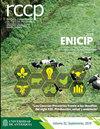不同蛋白质补充剂对牛卵母细胞回收和体外成熟的影响
IF 0.5
4区 农林科学
Q4 AGRICULTURE, DAIRY & ANIMAL SCIENCE
引用次数: 1
摘要
背景:补充蛋白质会影响卵母细胞的质量和成熟。目的:探讨胎牛血清(FBS)和牛血清白蛋白(BSA)浓度对牛卵母细胞恢复和体外成熟(IVM)的影响。方法:研究分为1期(卵母细胞恢复)和2期(IVM)。在第一阶段,根据使用的回收率(R)培养基进行三个实验:(R1) 10 vs. 20% FBS;(R2) 5 vs. 10% BSA;R1、R2和FBS+BSA组合(5+5%)效果最佳。在第二阶段,根据三个实验补充成熟培养基:(M1) 5 vs. 10% FBS;(M2) 0.4 vs. 0.8% BSA;(M3) M1、M2和FBS+BSA组合效果较好(5+0.8%)。结果:在第一阶段(R1和R2),添加10%牛血清和10%牛血清蛋白的培养基显示出更好的卵母细胞质量结果,并被定义为实验R3。在R3中,10%的FBS和FBS+BSA的组合(5+5%)可以恢复质量更好的卵母细胞。在第2阶段(M1和M2),根据积云细胞的成熟率和存活率,将FBS水平(5%和10%)和0.8% BSA水平的培养基定义为较好的培养基,因此将其定义为实验M3。在M3方面,各补品之间没有差异。结论:10%胎牛血清及5+5%胎牛血清+牛血清白蛋白组合均可获得未成熟卵母细胞。对于体外成熟,FBS(5%和10%)和BSA(0.8%)可单独或联合使用。本文章由计算机程序翻译,如有差异,请以英文原文为准。
Influence of different protein supplements on the recovery and in vitro maturation of bovine oocytes
Background: Oocyte quality and maturation are influenced by protein supplementation. Objective: To evaluate the influence of fetal bovine serum (FBS) and bovine serum albumin (BSA) concentrations on the recovery and in vitro maturation (IVM) of bovine oocytes. Methods: The study was divided into Stage 1 (oocyte recovery), and Stage 2 (IVM). In the first stage, three experiments were conducted according to the recovery (R) medium used: (R1) 10 vs. 20% FBS; (R2) 5 vs. 10% BSA; and (R3) the best results from R1, R2, and the combination of FBS+BSA (5+5%). Within the second stage, the maturation medium was supplemented according to three experiments: (M1) 5 vs. 10% FBS; (M2) 0.4 vs. 0.8% BSA; and (M3) better results of M1, M2, and the combination of FBS+BSA (5+0.8%). Results: In Stage 1 (R1 and R2), the media with 10% FBS and 10% BSA showed better oocyte quality results and were defined for experiment R3. In R3, the 10% FBS and the combination of FBS+BSA (5+5%) allowed recovery of better-quality oocytes. In Stage 2 (M1 and M2), media with both levels of FBS (5 and 10%) and 0.8% BSA were defined as better according to the maturation and viability rates of cumulus cells, so they were defined for experiment M3. In M3, no difference was noted among the supplements. Conclusions: For oocyte recovery, 10% FBS and the combination of FBS+BSA (5+5%) can be used to obtain immature oocytes. For the in vitro maturation, FBS (both levels, 5 and 10%) and BSA (0.8%) can be used alone or in combination.
求助全文
通过发布文献求助,成功后即可免费获取论文全文。
去求助
来源期刊

Revista Colombiana De Ciencias Pecuarias
AGRICULTURE, DAIRY & ANIMAL SCIENCE-
CiteScore
0.80
自引率
0.00%
发文量
18
审稿时长
6-12 weeks
期刊介绍:
The editors of Revista Colombiana de Ciencias Pecuarias (RCCP) welcome the submission of original manuscripts on experimental and clinical studies associated with the broad areas of animal sciences and veterinary medicine as they interface with biochemistry, molecular biology, physiology, pharmacology, toxicology, pathology, microbiology, parasitology, immunology and epidemiology. The scope of the journal includes studies of basic and applied research in animal management and production, feeding and nutrition, reproduction, breeding, genetics, animal welfare and behavior; as well as animal production focussed from biotechnology, soil science, agrostology, silvopastoral systems, livestock economics and the environment.
The criteria for acceptance of papers submitted for publication are originality, quality and clarity of the content. Each contribution must be based on original, unpublished research that has not been simultaneously submitted to other journals. All papers will be peer reviewed. All authors bear responsibility for ensuring the integrity and quality of their reported research. It is the author''s responsibility to secure permission to use figures or tables that have been published elsewhere.
Contributions may be classified as original research, review, rapid communication, clinical case studies or methodological articles, as well as news/commentaries or letters to the editor. Most review articles are invited by the editor. Authors interested in submitting a review article should contact the corresponding editor. Rapid publication of original manuscripts is a goal of the journal. Manuscripts must be written in English. Each manuscript is considered for publication with the understanding that it has not been simultaneously submitted to any other journal. Upon acceptance for publication, papers are subject to editorial review and revision.
 求助内容:
求助内容: 应助结果提醒方式:
应助结果提醒方式:


